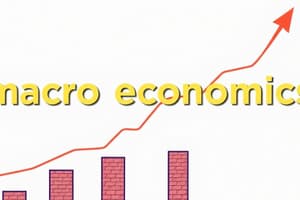Podcast
Questions and Answers
What typically occurs when the macroeconomy is performing well?
What typically occurs when the macroeconomy is performing well?
- Unemployment rates are at their highest levels.
- Inflation rates are significantly low.
- Jobs are easy to find, incomes are generally rising, and corporate profits are high. (correct)
- Jobs are scarce and incomes are stagnant.
Which of the following is a primary concern of macroeconomics?
Which of the following is a primary concern of macroeconomics?
- Competition among individual firms.
- Total national income and its determinants. (correct)
- Individual consumer spending habits.
- Price variations of specific goods.
How do sticky prices affect the macroeconomy?
How do sticky prices affect the macroeconomy?
- They consistently reflect the true market value.
- They help maintain equilibrium in supply and demand quickly.
- They can lead to short-term surpluses or shortages. (correct)
- They are adjusted frequently by firms.
What does macroeconomics primarily analyze?
What does macroeconomics primarily analyze?
Which statement is true regarding the behavior of the macroeconomy?
Which statement is true regarding the behavior of the macroeconomy?
What characterizes the interaction of the four components of the macroeconomy?
What characterizes the interaction of the four components of the macroeconomy?
What is defined as a prolonged and deep recession?
What is defined as a prolonged and deep recession?
During which phase of the business cycle does the economy experience growth from a trough to a peak?
During which phase of the business cycle does the economy experience growth from a trough to a peak?
What is hyperinflation?
What is hyperinflation?
Which of the following best defines the unemployment rate?
Which of the following best defines the unemployment rate?
Aggregate output is best described as which of the following?
Aggregate output is best described as which of the following?
In macroeconomics, which groups are identified as participants in the economy?
In macroeconomics, which groups are identified as participants in the economy?
What term is used to describe the cycle of short-term ups and downs in output in the economy?
What term is used to describe the cycle of short-term ups and downs in output in the economy?
What do households expect to earn by supplying funds to the money market?
What do households expect to earn by supplying funds to the money market?
What is the primary role of financial institutions in the money market?
What is the primary role of financial institutions in the money market?
Which financial instrument represents a share in a firm's ownership?
Which financial instrument represents a share in a firm's ownership?
Which of the following describes stagflation?
Which of the following describes stagflation?
What does monetary policy primarily involve?
What does monetary policy primarily involve?
What was 'fine-tuning' in the context of government policy?
What was 'fine-tuning' in the context of government policy?
What do transfer payments encompass?
What do transfer payments encompass?
Who receives payments for goods and services in the economy?
Who receives payments for goods and services in the economy?
In which market do households supply labor?
In which market do households supply labor?
What does the government receive from firms and households?
What does the government receive from firms and households?
What flows from the goods-and-services market to households?
What flows from the goods-and-services market to households?
Which statement accurately describes the roles of firms in the economy?
Which statement accurately describes the roles of firms in the economy?
How do households interact in the goods-and-services market?
How do households interact in the goods-and-services market?
Which statement is true regarding import interactions in the circular flow?
Which statement is true regarding import interactions in the circular flow?
What role does the rest of the world play in the goods-and-services market?
What role does the rest of the world play in the goods-and-services market?
What are the three broad market arenas identified?
What are the three broad market arenas identified?
Flashcards
Macroeconomics
Macroeconomics
The branch of economics that deals with the economy as a whole, focusing on aggregate variables like national income, total consumption, and overall price levels.
Microeconomics
Microeconomics
The study of individual industries and the decision-making behavior of individual firms and households.
Aggregate Behavior
Aggregate Behavior
Refers to the collective behavior of all households and firms within an economy, such as the sum of all their spending and production.
Sticky Prices
Sticky Prices
Signup and view all the flashcards
Economic Slump
Economic Slump
Signup and view all the flashcards
Healthy Macroeconomy
Healthy Macroeconomy
Signup and view all the flashcards
Money Market
Money Market
Signup and view all the flashcards
Treasury Bonds, Notes, or Bills
Treasury Bonds, Notes, or Bills
Signup and view all the flashcards
Corporate Bonds
Corporate Bonds
Signup and view all the flashcards
Shares of Stock
Shares of Stock
Signup and view all the flashcards
Dividends
Dividends
Signup and view all the flashcards
Fiscal Policy
Fiscal Policy
Signup and view all the flashcards
Business Cycle
Business Cycle
Signup and view all the flashcards
Aggregate Output
Aggregate Output
Signup and view all the flashcards
Recession
Recession
Signup and view all the flashcards
Depression
Depression
Signup and view all the flashcards
Expansion (or Boom)
Expansion (or Boom)
Signup and view all the flashcards
Contraction (or Recession or Slump)
Contraction (or Recession or Slump)
Signup and view all the flashcards
Unemployment Rate
Unemployment Rate
Signup and view all the flashcards
Inflation
Inflation
Signup and view all the flashcards
Circular Flow Diagram
Circular Flow Diagram
Signup and view all the flashcards
Transfer Payments
Transfer Payments
Signup and view all the flashcards
Goods-and-Services Market
Goods-and-Services Market
Signup and view all the flashcards
Labor Market
Labor Market
Signup and view all the flashcards
Money (Financial) Market
Money (Financial) Market
Signup and view all the flashcards
Household Spending
Household Spending
Signup and view all the flashcards
Income to Households
Income to Households
Signup and view all the flashcards
Tax Revenue
Tax Revenue
Signup and view all the flashcards
Government Spending
Government Spending
Signup and view all the flashcards
International Trade
International Trade
Signup and view all the flashcards
Study Notes
Principles of Economics - Twelfth Edition
- This is a textbook for Principles of Economics
- The textbook is published by Pearson
- The document is part of Part IV, Concepts and Problems, in Macroeconomics
- The publication date is 2017
Macroeconomics
- Examines the overall economy
- Focuses on factors such as aggregate output, unemployment, and inflation
- Macroeconomics examines total national income
- Considers aggregate consumption and investment
- Analyzes overall price levels, rather than individual prices
Macroeconomic Concerns
- Output growth
- Unemployment
- Inflation and deflation
Output Growth
- Business cycle: Short-term ups and downs in economic output
- Aggregate output: The total quantity of goods and services produced in a given period
- Recession: A period when aggregate output declines (two consecutive quarters)
- Depression: A prolonged and severe recession
- Expansion or boom: A period of output and employment growth
- Contraction, recession, or slump: A period from peak to trough with falling output and employment
Unemployment
- Unemployment rate: The percentage of the labor force that's unemployed
- Unemployment suggests that the aggregate labor market isn't in equilibrium
Inflation and Deflation
- Inflation: An increase in the overall price level
- Hyperinflation: A period of rapid price increases
- Deflation: A decrease in the overall price level
Components of the Macroeconomy
- Households
- Firms
- The government
- The rest of the world
The Circular Flow Diagram
- Shows flows of money and resources within an economy's sectors
- Transfer payments: Cash from the government to those who haven't provided labor or goods/services (welfare, veterans' benefits, etc.)
The Three Market Arenas
- Goods and Services Market: Households and government purchase; firms sell and buy goods and services
- Labor Market: Households offer labor; firms and government hire
- Money (Financial) Market: Households deposit funds; firms and government borrow and lend funds
The Role of the Government in the Macroeconomy
- Fiscal policy: Government decisions concerning spending and taxation
- Monetary policy: Central bank tools to control short-term interest rates
A Brief History of Macroeconomics
- Great Depression: Severe economic contraction and high unemployment beginning in 1929
- Fine-tuning: Government's role in regulating inflation and unemployment (coined by Walter Heller)
- Stagflation: A situation with high inflation and high unemployment
Macroeconomics in Literature
- The Great Gatsby: Set in the 1920s
- The Grapes of Wrath: Set in the early 1930s
- These literary works reflect economic phenomena
Studying That Suits You
Use AI to generate personalized quizzes and flashcards to suit your learning preferences.
Related Documents
Description
This quiz covers key concepts in macroeconomics from the 'Principles of Economics - Twelfth Edition' textbook. It focuses on output growth, unemployment, inflation, and the business cycle. Test your understanding of these fundamental economic principles and their impact on the overall economy.




